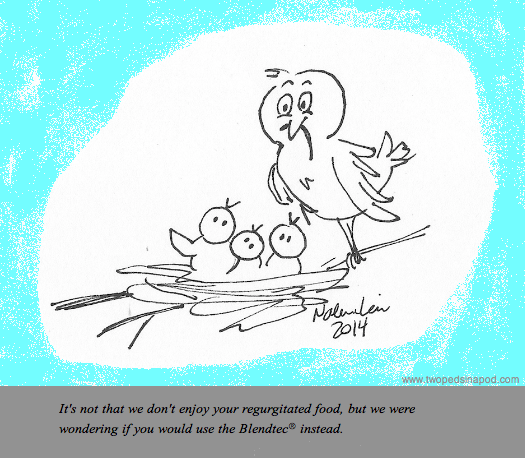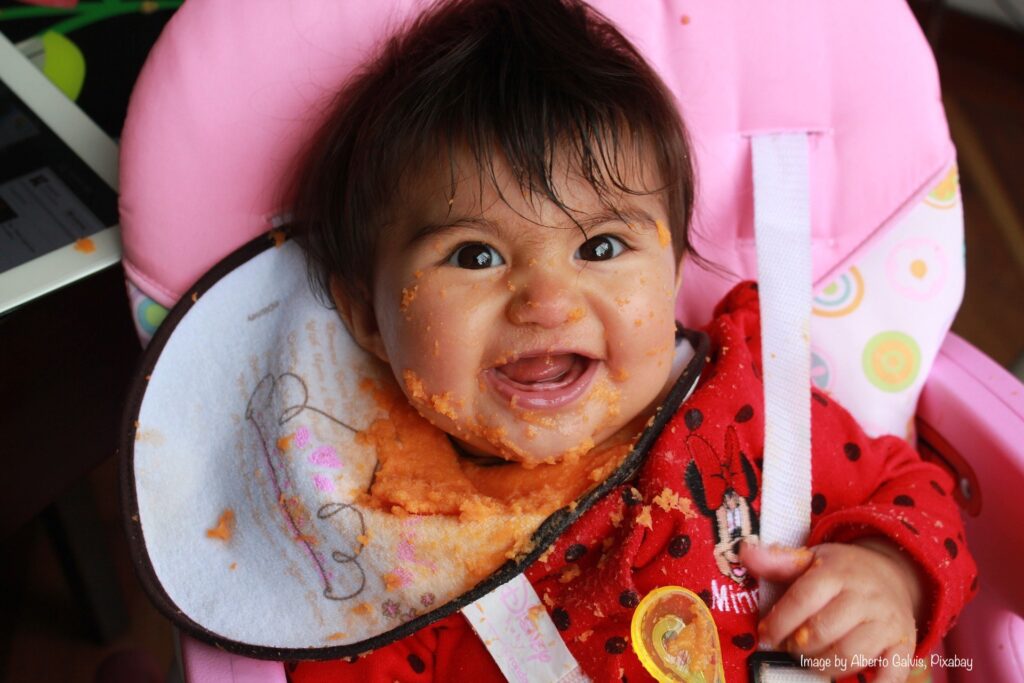As we said to Robin Young on NPR’s Here and Now, “A lot of life’s issues all boil down to the essentials of life…eat, sleep, drink, pee, poop and love.” Here’s our update on baby food: WHEN, HOW, and WHAT to start feeding your baby.

Remember:
1) It’s not just about the food. It’s about teaching your child to eat when hungry and to stop when not hungry.
2) Eating a meal with family is social as well as nutritious. Keep eating pleasant and relaxed. Avoid force-feeding or tricking your child into eating. Feed your baby along with other family members so your baby can learn to eat by watching others eat.
3) Babies start out eating pureed foods on a spoon between 4-6 months and progress to finger foods when physically capable, usually between 7-9 months. Teeth are not required; hand to mouth coordination is required.
The first feeding: Babies expect a breast or a bottle when hungry. So make sure your baby is happy and awake but NOT hungry the first time you feed her solid food because at this point she is learning a skill, not eating for nutrition. Wait about an hour after a milk feeding when she is playful and ready to try something new. Keep a camera nearby because babies make great faces when eating food for the first time. Many parents like to start new foods in the morning so that they have the entire day to make sure it agrees with their baby. Watch for rash or stomach upset.
WHAT should you feed your baby first? There is no one right answer to this question.
- The easiest food to offer is one that is already on the breakfast, lunch, or dinner table that is easy to mush up.
- In some cultures, a baby’s first food is a smash of lentils and rice. In other cultures it’s small bits of hard-boiled egg or a rice porridge. The bottom line: it doesn’t matter much what you start with, as long as it’s nutritious. Dr. Kardos is proud to say that she fed her nephew his first solid food: watermelon! (He loved it).
- Avoid honey before one year of age because honey can cause botulism in infants.
- Add iron-containing food sooner rather than later. Pediatricians recommend a diet with iron-containing solid foods because a baby’s iron needs will eventually outstrip what she stored from her mother before birth as well as what she can get from breast milk or formula. Iron-containing food include iron-fortified baby cereal (such as oatmeal), pureed meats (such as chicken, beef or fish) or smashed lentils or black beans.
- If feeding baby cereals, make them with formula or breast milk, not water or juice, for more nutritional “oomph.”
- If your baby has eczema and/or an egg allergy, your baby may be predisposed to a peanut allergy. Ask your doctor if your baby is a candidate for daily peanut protein feedings in order to prevent a peanut allergy. Read the guidelines here and instructions for the feedings here. Otherwise, you can start peanut butter whenever you want- it’s really yummy mixed into oatmeal.
- Variety is the spice of life: you do not need to feed the same food day after day. In particular, because of concerns of arsenic, avoid over indulgence in rice cereal. No need to avoid certain foods because of the fear of inducing food allergies. This is a change from recommendations issued about 15 years ago. Focus more on avoiding choking hazards than on avoiding theoretically allergenic foods.
- Not all kids like all foods. Don’t worry if your baby hates carrots or bananas. Many other choices are available. At the same time, you can offer a previously rejected food multiple times because taste buds change.
HOW to feed:
Sit your baby in a high chair at the table where your family eats meals.
Some babies will learn in just one feeding to swallow without gagging and to open their mouths when they see the spoon coming. Other babies need more time. If your baby becomes upset, end the meal. Some babies take several weeks to catch on to the idea of eating solids. Try one new food at a time. Then, if your baby has a reaction to the food, you’ll know what to blame.
Some babies just never seem to like mushed up foods and prefer to suck on foods at first (like Dr. Kardos’s nephew did with his watermelon). One practice called baby-led weaning describes another way of introducing solids.
If you prefer to buy “baby food,” know that stage one and stage two baby foods are similar. No need to test all stage one foods before going onto stage two. The consistency of the food is the same. The stages differ in the size of the containers. Some stage two foods combine ingredients. Combinations are fine as long as you know your baby already tolerates each individual ingredient (i.e. “peas and carrots” are fine if she’s already had each one alone). Avoid the dessert foods. Your baby does not need fillers such as cornstarch and concentrated sweets.
Be forewarned: poop changes with solid foods. Usually it gets more firm or has more odor. Food is not always fully digested at this age and thus shows up in the poop. Wait until you see a sweet potato poop!
By six months, babies replace at least one milk feeding with a solid food meal. Many babies are up to three meals a day by 6 months, some are eating one meal per day. Starting at six months, for cup training purposes, you can offer a cup with water at meals. Juice is not recommended. Juice contains a lot of sugar and very little nutrition.
WHAT ABOUT FINGER FOODS? WHEN CAN MY BABY PICK UP HIS OWN FOOD?
Offer finger foods when your baby can sit alone and manipulate a toy without falling over. When you see your baby delicately picking up a piece of lint off the floor and putting it into his mouth, he’s probably ready! Usually this occurs between 7-9 months of age. Even with no teeth your baby can gum-smash a variety of finger foods. Examples include “Toasted Oats” (Cheerios), which are low in sugar and dissolve in your mouth eventually without any chewing, ½ cheerio-sized cooked vegetable, soft fruit, ground meat or pieces of baked chicken, beans, tofu, egg yolk, soft cheese, small pieces of pasta. Start by putting a finger food on the tray while you are spoon feeding and see what your child does. They often do better feeding themselves finger foods rather than having someone else “dump the lump” into their mouths.
Finger food sample meals: Breakfast: cereal, pieces of fruit, egg. Lunch: pasta or rice, lentils or beans, cooked vegetables in pieces, pieces of cheese. Dinner: soft meat such as chicken or ground beef, cooked veggies and/or fruit, bits of potato, or cereal. Need other ideas? Check out this post on finger foods. By nine months, kids can eat most of the adult meal at the table, just avoid choking hazards such as raw vegetables, chewy meats, nuts, and hot dogs. You can use breast feedings or formula bottles as snacks between meals or with some meals. By this age, it is normal for babies to average 16-24 oz of formula daily or 3-4 breast feedings daily.
Avoid fried foods and highly processed foods. Do not buy “toddler meals” which are high in salt and “fillers.” Avoid baby junk food- if the first three ingredients are “flour, water, sugar/corn syrup”, don’t buy it. We are amazed at the baby-junk food industry that insinuate that “fruit chews,” “yogurt bites” and “cookies” have a place in anyone’s diet. Instead, feed your child eat REAL fruit, ACTUAL yogurt, and healthy carbs such as pasta, cous-cous, or rice.
Other important food-related topics:
Organic and conventional foods have the same nutritional content. They differ in price, and they differ in pesticide exposure, but no study to date has shown any health differences in children who consume organic vs conventional foods. For more information, see this American Academy article and this study as well as our own prior post about organic vs conventional foods.
About fish: For years, experts fretted about pregnant women and children exposing themselves to high mercury levels by eating contaminated fish. However, the realization that fish is packed with nutrition, and the emergence of data showing that only a few types of fish contain significant mercury levels, led the FDA to encourage fish intake in young children and pregnant women. Please check this FDA advice for specific information about which fish to offer your child.
SAFETY ALERT:
Children should always eat while sitting down and not while crawling or walking in order to AVOID CHOKING. Also, you don’t want to create a constantly munching toddler who will grow into a constantly munching ten year old.
Bon appetite,
Julie Kardos, MD and Naline Lai, MD
© 2017 Two Peds in a Pod®
Updated from our original 2009 post

